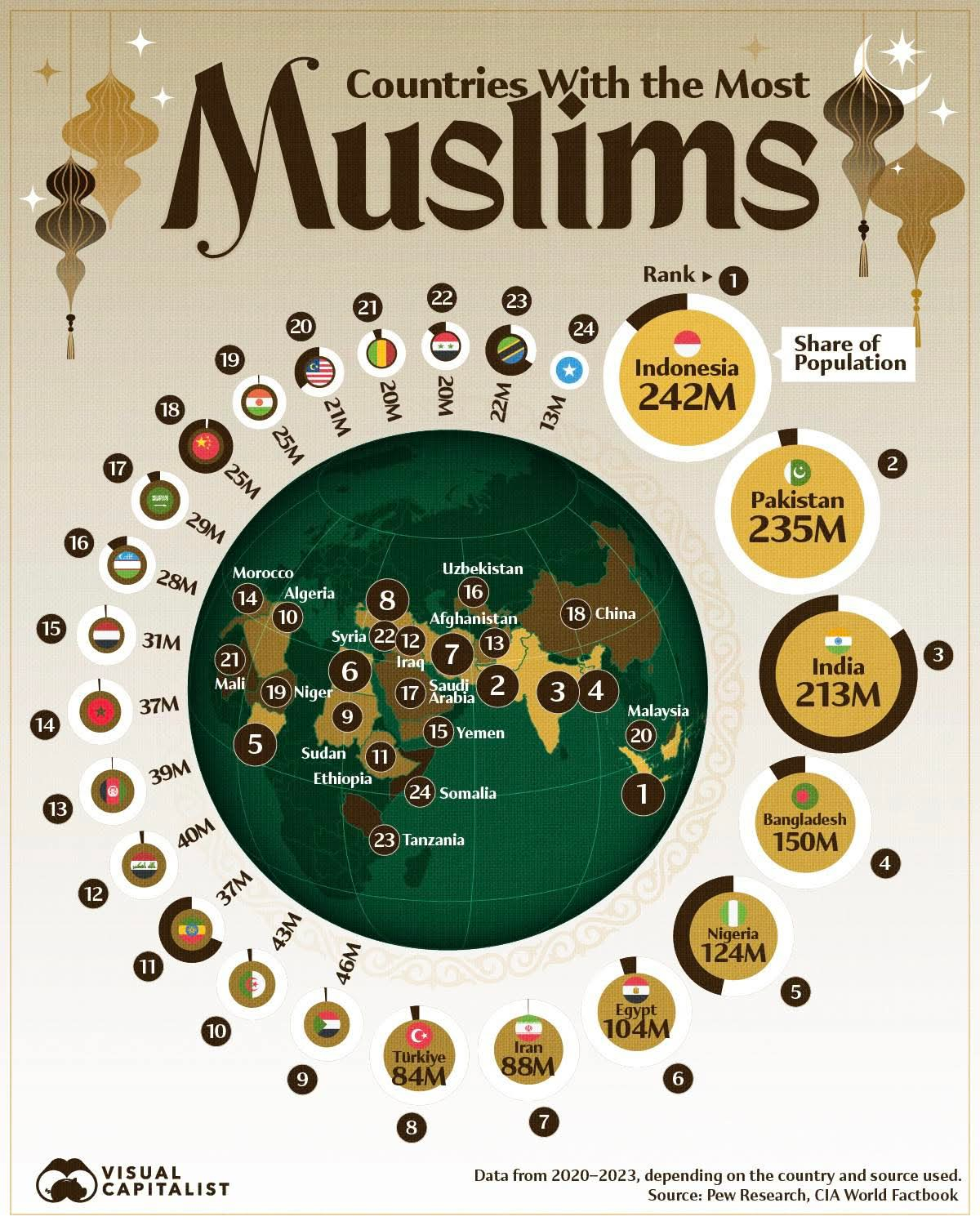Countries With the Most Muslims (% Population)
1. Indonesia - 242M (87.0%)
2. Pakistan - 235M (96.3%)
3. India - 213M (15.3%)
4. Bangladesh - 150M (91.0%)
5. Nigeria - 124M (53.5%)
6. Egypt - 104M (95%)
7. Iran - 88M (99.8%)
8. Turkey - 84M (97%)
9. Sudan - 46M (99%)
10. Algeria - 43M (98.0%)
11. Iraq - 40M (98%)
12. Afghanistan - 39M (99.7%)
13. Ethiopia - 37M (31.3%)
14. Morocco - 37M (99.0%)
15. Yemen - 31M (99.1%)
16. Saudi Arabia - 29M (92.7%)
17. Uzbekistan - 28M (88.0%)
18. China - 25M (1.4%)
19. Nigér - 25M (99.3%)
20. Tanzania - 22M (34.1%)
21. Malaysia - 21M (63.5%)
22. Mali - 20M (93.9%)
23. Syria - 20M (87.0%)
24. Somalia - 13M (99.8%)
The data comes from two complementary sources: Pew Research, which tracks global religious affiliation, and the CIA World Factbook, which publishes national demographic splits.
Countries With the Largest Muslim Populations: Islam is the world’s second-largest religion, with 1.8 billion Muslims dispersed across every continent. Due to data constraints, the most recent figures between 2020–2023 have been utilized, depending on availability per country. Africa is home to some of the fastest-growing Muslim populations. Nigeria, already the continent’s most populous country, now counts over 124 million Muslims, comprising more than half its citizens. In North Africa, Egypt and Algeria each report that roughly 95-98% of their inhabitants identify as Muslim, reflecting centuries-old cultural and religious continuity.
1. Indonesia - 242M (87.0%)
2. Pakistan - 235M (96.3%)
3. India - 213M (15.3%)
4. Bangladesh - 150M (91.0%)
5. Nigeria - 124M (53.5%)
6. Egypt - 104M (95%)
7. Iran - 88M (99.8%)
8. Turkey - 84M (97%)
9. Sudan - 46M (99%)
10. Algeria - 43M (98.0%)
11. Iraq - 40M (98%)
12. Afghanistan - 39M (99.7%)
13. Ethiopia - 37M (31.3%)
14. Morocco - 37M (99.0%)
15. Yemen - 31M (99.1%)
16. Saudi Arabia - 29M (92.7%)
17. Uzbekistan - 28M (88.0%)
18. China - 25M (1.4%)
19. Nigér - 25M (99.3%)
20. Tanzania - 22M (34.1%)
21. Malaysia - 21M (63.5%)
22. Mali - 20M (93.9%)
23. Syria - 20M (87.0%)
24. Somalia - 13M (99.8%)
The data comes from two complementary sources: Pew Research, which tracks global religious affiliation, and the CIA World Factbook, which publishes national demographic splits.
Countries With the Largest Muslim Populations: Islam is the world’s second-largest religion, with 1.8 billion Muslims dispersed across every continent. Due to data constraints, the most recent figures between 2020–2023 have been utilized, depending on availability per country. Africa is home to some of the fastest-growing Muslim populations. Nigeria, already the continent’s most populous country, now counts over 124 million Muslims, comprising more than half its citizens. In North Africa, Egypt and Algeria each report that roughly 95-98% of their inhabitants identify as Muslim, reflecting centuries-old cultural and religious continuity.
🕌 Countries With the Most Muslims (% Population)
1. 🇮🇩 Indonesia - 242M (87.0%)
2. 🇵🇰 Pakistan - 235M (96.3%)
3. 🇮🇳 India - 213M (15.3%)
4. 🇧🇩 Bangladesh - 150M (91.0%)
5. 🇳🇬 Nigeria - 124M (53.5%)
6. 🇪🇬 Egypt - 104M (95%)
7. 🇮🇷 Iran - 88M (99.8%)
8. 🇹🇷 Turkey - 84M (97%)
9. 🇸🇩 Sudan - 46M (99%)
10. 🇩🇿 Algeria - 43M (98.0%)
11. 🇮🇶 Iraq - 40M (98%)
12. 🇦🇫 Afghanistan - 39M (99.7%)
13. 🇪🇹 Ethiopia - 37M (31.3%)
14. 🇲🇦 Morocco - 37M (99.0%)
15. 🇾🇪 Yemen - 31M (99.1%)
16. 🇸🇦 Saudi Arabia - 29M (92.7%)
17. 🇺🇿 Uzbekistan - 28M (88.0%)
18. 🇨🇳 China - 25M (1.4%)
19. 🇳🇪 Nigér - 25M (99.3%)
20. 🇹🇿 Tanzania - 22M (34.1%)
21. 🇲🇾 Malaysia - 21M (63.5%)
22. 🇲🇱 Mali - 20M (93.9%)
23. 🇸🇾 Syria - 20M (87.0%)
24. 🇸🇴 Somalia - 13M (99.8%)
📌 The data comes from two complementary sources: Pew Research, which tracks global religious affiliation, and the CIA World Factbook, which publishes national demographic splits.
Countries With the Largest Muslim Populations: Islam is the world’s second-largest religion, with 1.8 billion Muslims dispersed across every continent. Due to data constraints, the most recent figures between 2020–2023 have been utilized, depending on availability per country. Africa is home to some of the fastest-growing Muslim populations. Nigeria, already the continent’s most populous country, now counts over 124 million Muslims, comprising more than half its citizens. In North Africa, Egypt and Algeria each report that roughly 95-98% of their inhabitants identify as Muslim, reflecting centuries-old cultural and religious continuity.
0 Comments
0 Shares









